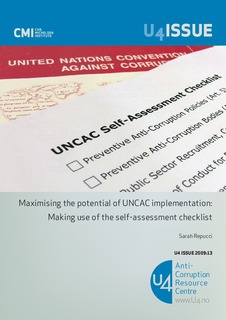| dc.description.abstract | The UN Convention against Corruption (UNCAC) offers States Parties a unique framework to strengthen their ability to prevent and combat corruption. The self‑assessment checklist, which was developed as part of the review mechanism for the Convention, is one of the few available methods for assessment for which the state provides its own information, maximising its ownership of the process. Moreover, the self‑assessment checklist can have follow‑on effects, bringing several potential positive outcomes as part of the corruption and broader governance assessment processes. However, success with the checklist should not be taken for granted. The valuable information gathered by the checklist process needs to be utilised for reform processes in the country by the country. Achieving its full potential requires a concrete long‑term commitment from the state at the highest levels, and the coordinated support of donors. This U4 Issue outlines the potential benefits as well as the challenges the checklist poses, and makes recommendations for States Parties, donors, and UNODC to ensure that the benefits are realised. | |
